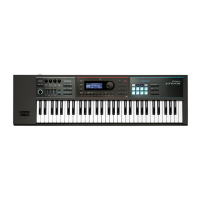45
MFX/Chorus/Reverb Parameters
19: STEP PAN
This uses a 16-step sequence to vary the panning of the sound.
L out
Step Pan
Step Pan
Parameter Value Explanation
Step 01–16 L64–63R Pan at each step
Rate # 0.05–10.00[Hz], note Rate at which the 16-step sequence will cycle
Attack # 0–127 Speed at which the pan changes between steps
Input Sync Sw OFF, ON
Species whether an input note will cause the
sequence to resume from the rst step of the
sequence (ON) or not (OFF)
Input Sync
Threshold
0–127 Volume at which an input note will be detected
Level 0–127 Output level
MEMO
You can use MFX control to restart the step sequence from the beginning (p. 18,
p. 24).
20: SLICER
By applying successive cuts to the sound, this eect turns a conventional sound into
a sound that appears to be played as a backing phrase. This is especially eective
when applied to sustain-type sounds.
L out
Slicer
Slicer
Parameter Value Explanation
Step 01–16 0–127 Level at each step
Rate # 0.05–10.00[Hz], note Rate at which the 16-step sequence will cycle
Attack # 0–127 Speed at which the level changes between steps
Input Sync Sw OFF, ON
Species whether an input note will cause the
sequence to resume from the rst step of the
sequence (ON) or not (OFF)
Input Sync
Threshold
0–127 Volume at which an input note will be detected
Mode
Sets the manner in which the volume changes as one step progresses to
the next.
LEGATO
The change in volume from one step’s level to
the next remains unaltered.
If the level of a following step is the same as the
one preceding it, there is no change in volume.
SLASH
The level is momentarily set to 0 before
progressing to the level of the next step. This
change in volume occurs even if the level of the
following step is the same as the preceding step.
Shue # 0–127
Timing of volume changes in levels for even-
numbered steps (step 2, step 4, step 6...).
The higher the value, the later the beat
progresses.
Level 0–127 Output level
MEMO
You can use MFX control to restart the step sequence from the beginning (p. 18,
p. 24).
21: ROTARY
The Rotary eect simulates the sound of the rotary speakers often used with the
electric organs of the past. Since the movement of the high range and low range
rotors can be set independently, the unique type of modulation characteristic of
these speakers can be simulated quite closely. This eect is most suitable for electric
organ Tones.
Rotary
Parameter Value Explanation
Speed #
Simultaneously switch the rotational speed of the low frequency rotor
and high frequency rotor.
SLOW Slows down the rotation to the Slow Rate.
FAST Speeds up the rotation to the Fast Rate.
Woofer Slow Speed 0.05–10.00[Hz] Slow speed (SLOW) of the low frequency rotor
Woofer Fast Speed 0.05–10.00[Hz] Fast speed (FAST) of the low frequency rotor
Woofer Acceleration 0–15
Adjusts the time it takes the low frequency rotor
to reach the newly selected speed when switching
from fast to slow (or slow to fast) speed.
Woofer Level 0–127 Volume of the low frequency rotor
Tweeter Slow Speed 0.05–10.00[Hz]
Settings of the high frequency rotor
The parameters are the same as for the low
frequency rotor.
Tweeter Fast Speed 0.05–10.00[Hz]
Tweeter
Acceleration
0–15
Tweeter Level 0–127
Separation 0–127 Spatial dispersion of the sound
Level # 0–127 Output level
22: VK ROTARY
This type provides modied response for the rotary speaker, with the low end
boosted further.
This eect features the same specications as the VK-7’s built-in rotary speaker.
Rotary
2-Band EQ
2-Band EQ
Parameter Value Explanation
Speed #
Rotational speed of the rotating speaker
SLOW Slow
FAST Fast
Brake # OFF, ON
Switches the rotation of the rotary speaker.
When this is turned on, the rotation will gradually
stop. When it is turned o, the rotation will
gradually resume.
Woofer Slow Speed 0.05–10.00[Hz] Low-speed rotation speed of the woofer
Woofer Fast Speed 0.05–10.00[Hz] High-speed rotation speed of the woofer
Woofer Trans Up 0–127
Adjusts the rate at which the woofer rotation
speeds up when the rotation is switched from
SLOW to FAST.
Woofer Trans Down 0–127
Adjusts the rate at which the woofer rotation
speeds up when the rotation is switched from
FAST to SLOW.
Woofer Level 0–127 Volume of the woofer
Tweeter Slow Speed 0.05–10.00[Hz]
Settings of the tweeter
The parameters are the same as for the woofer.
Tweeter Fast Speed 0.05–10.00[Hz]
Tweeter Trans Up 0–127
Tweeter Trans Down 0–127
Tweeter Level 0–127
Spread 0–10 Sets the rotary speaker stereo image.
Low Gain -15–+15[dB] Gain of the low range
High Gain -15–+15[dB] Gain of the high range
Level # 0–127 Output level
Type
STANDARD, STACK,
CLEAN
Type of speaker
3
3
3
3

